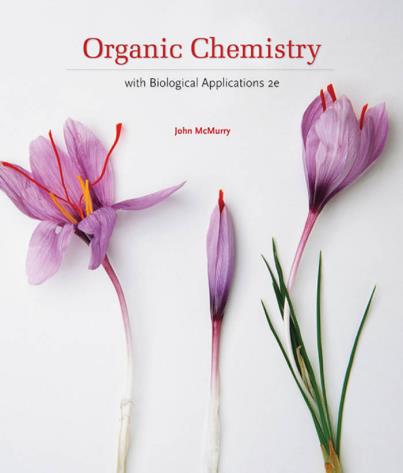
Organic Chemistry with Biological Applications 2e John McMury
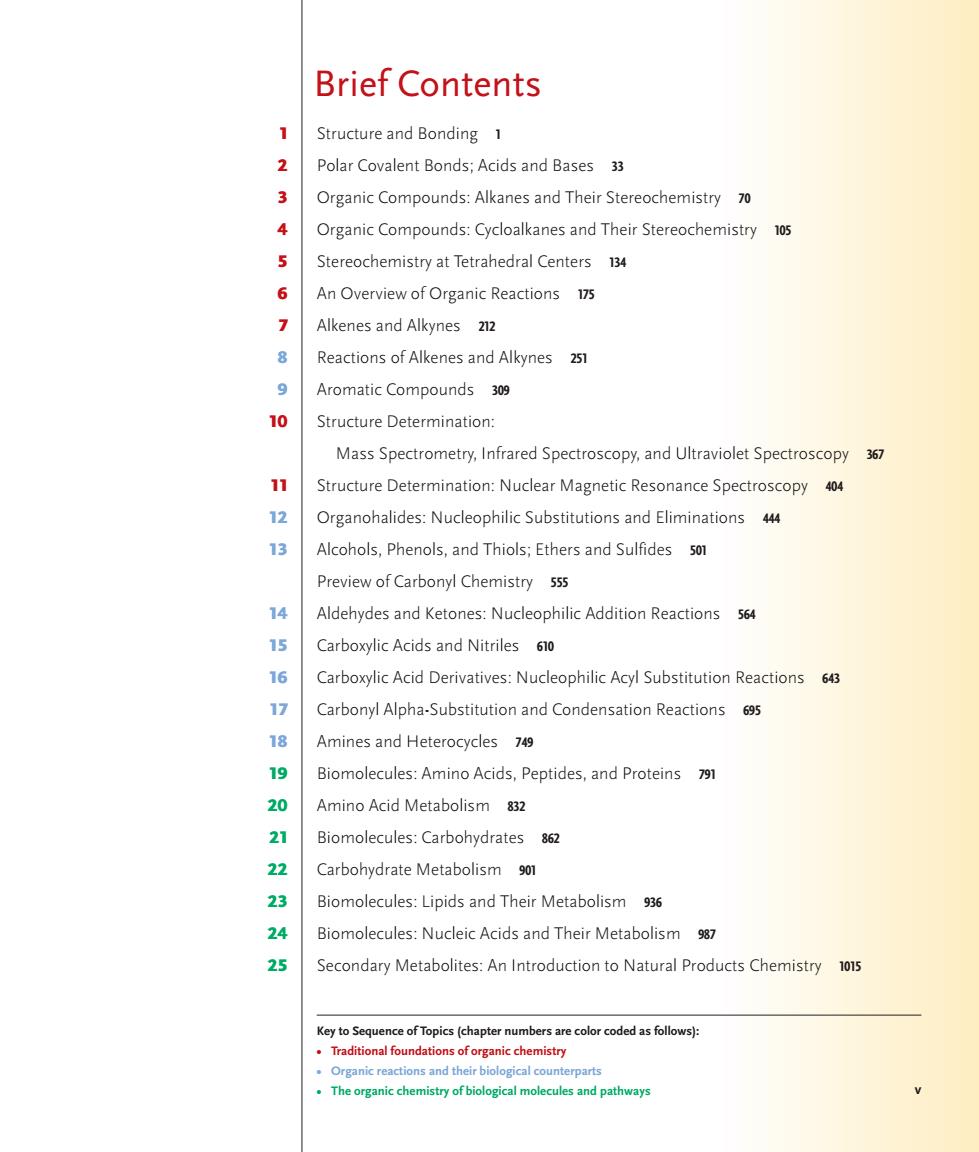
Brief Contents Structure and Bonding 1 Polar Covalent Bonds:Acids and Bases 33 3 Organic Compounds:Alkanes and Their Stereochemistry 70 Organic Compounds:Cycloalkanes and Their Stereochemistry 105 Stereochemistry at Tetrahedral Centers 134 6 An Overview of Organic Reactions 17s 7 Alkenes and Alkynes 212 Reactions of Alkenes and Alkynes 251 9 Aromatic Compounds 309 10 Structure Determination: Mass Spectrometry,Infrared Spectroscopy,and Ultraviolet Spectroscopy 367 11 Structure Determination:Nuclear Magnetic Resonance Spectroscopy 404 12 Organohalides:Nucleophilic Substitutions and Eliminations 13 Alcohols,Phenols,and Thiols;Ethers and Sulfides 501 Preview of Carbonyl Chemistry ss5 14 Aldehydes and Ketones:Nucleophilic Addition Reactions 564 15 Carboxylic Acids and Nitriles 610 16 Carboxylic Acid Derivatives:Nucleophilic Acyl Substitution Reactions 64 17 Carbonyl Alpha-Substitution and Condensation Reactions 695 Amines and Heterocycles 749 19 Biomolecules:Amino Acids,Peptides,and Proteins79 20 Amino Acid Metabolism 832 21 Biomolecules:Carbohydrates 862 22 Carbohydrate Metabolism 901 Biomolecules:Lipids and Their Metabolism 936 24 Biomolecules:Nucleic Acids and Their Metabolism 98i Secondary Metabolites:An Introduction to Natural Products Chemistry 1015 Key t eof Topics (chapter as follows) oun ns of organic chemis stry Organic rea ons na th nterparts The organic chemistry of biological molecules and pathways
Brief Contents 1 Structure and Bonding 1 2 Polar Covalent Bonds; Acids and Bases 33 3 Organic Compounds: Alkanes and Their Stereochemistry 70 4 Organic Compounds: Cycloalkanes and Their Stereochemistry 105 5 Stereochemistry at Tetrahedral Centers 134 6 An Overview of Organic Reactions 175 7 Alkenes and Alkynes 212 8 Reactions of Alkenes and Alkynes 251 9 Aromatic Compounds 309 10 Structure Determination: Mass Spectrometry, Infrared Spectroscopy, and Ultraviolet Spectroscopy 367 11 Structure Determination: Nuclear Magnetic Resonance Spectroscopy 404 12 Organohalides: Nucleophilic Substitutions and Eliminations 444 13 Alcohols, Phenols, and Thiols; Ethers and Sulfides 501 Preview of Carbonyl Chemistry 555 14 Aldehydes and Ketones: Nucleophilic Addition Reactions 564 15 Carboxylic Acids and Nitriles 610 16 Carboxylic Acid Derivatives: Nucleophilic Acyl Substitution Reactions 643 17 Carbonyl Alpha-Substitution and Condensation Reactions 695 18 Amines and Heterocycles 749 19 Biomolecules: Amino Acids, Peptides, and Proteins 791 20 Amino Acid Metabolism 832 21 Biomolecules: Carbohydrates 862 22 Carbohydrate Metabolism 901 23 Biomolecules: Lipids and Their Metabolism 936 24 Biomolecules: Nucleic Acids and Their Metabolism 987 25 Secondary Metabolites: An Introduction to Natural Products Chemistry 1015 Key to Sequence of Topics (chapter numbers are color coded as follows): • Traditional foundations of organic chemistry • Organic reactions and their biological counterparts • The organic chemistry of biological molecules and pathways v 39144_ FM_i-xxiv.indd v 8/26/09 10:48:42 AM
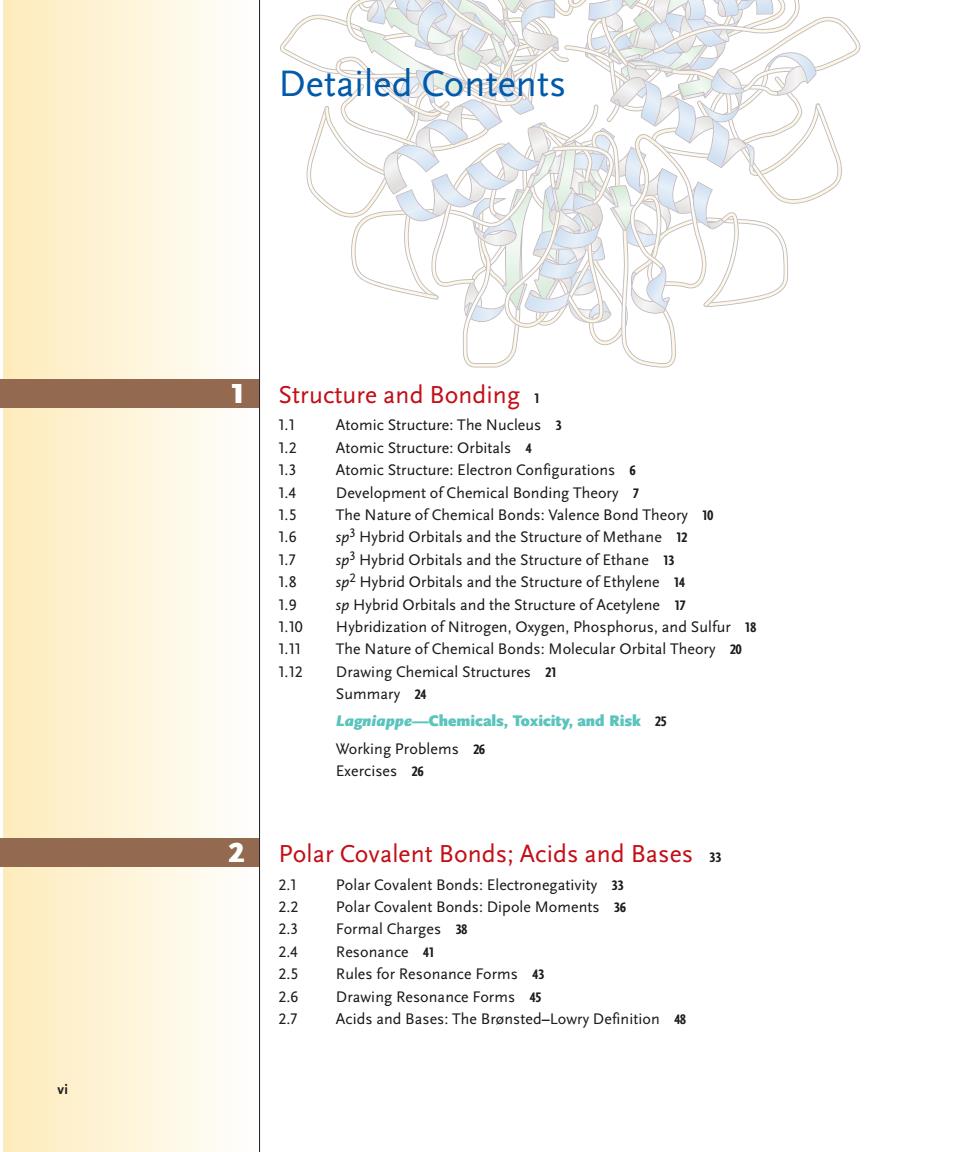
Detailed Contents Structure and Bonding 1 1.1 Atomic Structure:The Nucleus 3 1.2 Atomic Structure:Orbitals4 1.3 Atomic Structure:Electron Configurations 6 14 Development of Chemical Bonding Theory 7 15 The Nature of Chemical Bonds:Valence e Bond Theory 10 1.6 spHybrid Orbitals and the Structure of Methane 12 1.7 sp3 Hybrid Orbitals and the Structure of Ethane 13 1.8 so2 Hybrid orbitals and the structure of Ethylene 14 1.9 sp Hybrid Orbitals and the Structure of Acetylene 17 11 Hybridization of Nitrogen,Oxygen,Phosphorus,and Sulfur 18 111 The Nature of Chemical Bonds:Molecular Orbital Theory 20 1.12 Drawing Chemical Structures 21 Summary 24 Lagniappe-Chemicals,Toxicity,and Risk 25 Working Problems 26 Exercises 26 Polar Covalent Bonds;Acids and Bases 3 2.1 Polar Covalent Bonds:Electronegativity 33 22 Polar Covalent Bonds:Dipole Moments 36 2.3 Formal Charges 38 24 Resonance 41 2.5 Rules for Resonance Forms 43 Drawing Resonance Forms 45 > Acids and Bases:The Bronsted-Lowry Definition 48 vi
vi Structure and Bonding 1 1.1 Atomic Structure: The Nucleus 3 1.2 Atomic Structure: Orbitals 4 1.3 Atomic Structure: Electron Configurations 6 1.4 Development of Chemical Bonding Theory 7 1.5 The Nature of Chemical Bonds: Valence Bond Theory 10 1.6 sp3 Hybrid Orbitals and the Structure of Methane 12 1.7 sp3 Hybrid Orbitals and the Structure of Ethane 13 1.8 sp2 Hybrid Orbitals and the Structure of Ethylene 14 1.9 sp Hybrid Orbitals and the Structure of Acetylene 17 1.10 Hybridization of Nitrogen, Oxygen, Phosphorus, and Sulfur 18 1.11 The Nature of Chemical Bonds: Molecular Orbital Theory 20 1.12 Drawing Chemical Structures 21 Summary 24 Lagniappe—Chemicals, Toxicity, and Risk 25 Working Problems 26 Exercises 26 Polar Covalent Bonds; Acids and Bases 33 2.1 Polar Covalent Bonds: Electronegativity 33 2.2 Polar Covalent Bonds: Dipole Moments 36 2.3 Formal Charges 38 2.4 Resonance 41 2.5 Rules for Resonance Forms 43 2.6 Drawing Resonance Forms 45 2.7 Acids and Bases: The Brønsted–Lowry Definition 48 1 2 Detailed Contents 39144_ FM_i-xxiv.indd vi 8/26/09 10:48:43 AM
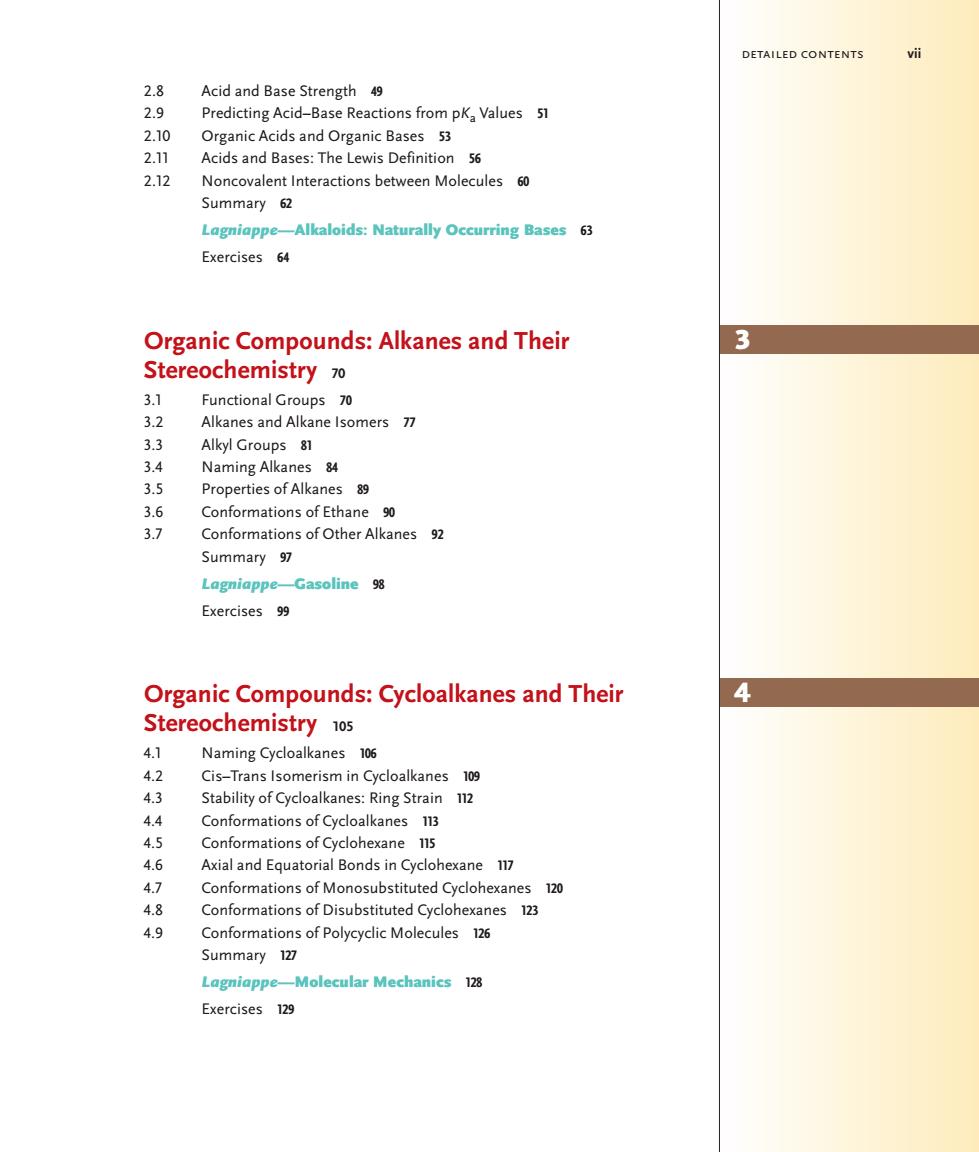
DETAILED CONTENTS 2.8 Acid and Base Strength 49 2.9 Predicting Acid-Base Reactions from pK Values 51 2.10 Organic Acids and Organic Bases 53 2 Acids and Bases:The Lewis Definition 56 2.12 Noncovalent Interactions between Molecules 60 Summary 62 Lagniappe-Alkaloids:Naturally Occurring Bases 63 Exercises 64 Organic Compounds:Alkanes and Their Stereochemistry 70 3.1 Functional Groups 70 32 Alkanes and Alkane Isomers 77 33 Alkyl Groups 81 3.4 Naming Alkanes 84 3.5 Properties of alkanes 89 3.6 Conformations of Ethane 3 Conformations of Other Alkanes 92 Summary 97 Lagniappe-Gasoline 9 Exercises99 Organic Compounds:Cycloalkanes and Their Stereochemistry 10s 4.1 Naming Cycloalkanes 106 Cis-Trans Isomerism in Cycloalkanes 109 4.3 Stability of Cycloalkanes:Ring Strain 112 4.4 Conformations of Cycloalkanes 113 4.5 Conformations of Cyclohexane 115 Axial and Equatorial Bonds in Cyclohexane 17 4.7 Conformations of Monosubstituted Cyclohexanes 120 4.8 Conformations of Disubstituted Cyclohexanes 123 4.9 Conformations of Polycyclic Molecules 126 Summary 127 Lagniappe-Molecular Mechanics 128 Exercises 129
detailed contents vii 2.8 Acid and Base Strength 49 2.9 Predicting Acid–Base Reactions from pKa Values 51 2.10 Organic Acids and Organic Bases 53 2.11 Acids and Bases: The Lewis Definition 56 2.12 Noncovalent Interactions between Molecules 60 Summary 62 Lagniappe—Alkaloids: Naturally Occurring Bases 63 Exercises 64 Organic Compounds: Alkanes and Their Stereochemistry 70 3.1 Functional Groups 70 3.2 Alkanes and Alkane Isomers 77 3.3 Alkyl Groups 81 3.4 Naming Alkanes 84 3.5 Properties of Alkanes 89 3.6 Conformations of Ethane 90 3.7 Conformations of Other Alkanes 92 Summary 97 Lagniappe—Gasoline 98 Exercises 99 Organic Compounds: Cycloalkanes and Their Stereochemistry 105 4.1 Naming Cycloalkanes 106 4.2 Cis–Trans Isomerism in Cycloalkanes 109 4.3 Stability of Cycloalkanes: Ring Strain 112 4.4 Conformations of Cycloalkanes 113 4.5 Conformations of Cyclohexane 115 4.6 Axial and Equatorial Bonds in Cyclohexane 117 4.7 Conformations of Monosubstituted Cyclohexanes 120 4.8 Conformations of Disubstituted Cyclohexanes 123 4.9 Conformations of Polycyclic Molecules 126 Summary 127 Lagniappe—Molecular Mechanics 128 Exercises 129 3 4 39144_ FM_i-xxiv.indd vii 8/26/09 10:48:49 AM

DETAILED CONTENTS 5 Stereochemistry at Tetrahedral Centers 134 5.1 Enantiomers and the Tetrahedral Carbon 135 52 The Reason for Handedness in Molecules:Chirality 136 Optical Activity140 5.4 Pasteur's Discovery of Enantiomers 142 55 Sequence Rules for Specifying Configuration 143 5.6 Diastereomers 149 57 Meso Compounds 151 5.8 Racemic Mixtures and the Resolution of Enantiomers 154 5.9 A Review of Isomerism 156 5.10 Chirality at Nitrogen,Phosphorus,and Sulfur 158 5.11 Prochirality 159 5.12 Chirality in Nature and Chiral Environments 162 Summary 164 Logniappe-Chiral Drugs 165 Exercises 166 6 An Overview of Organic Reactions 17s 6.1 Kinds of Organic Reactions 176 6.2 How Organic Reactions Occur:Mechanisms 17 6.3 Radical reactions 18 4 Polar Reactions 181 65 An Example of a Polar Reaction:Addition of H2O to Ethylene 186 6. Using Curved Arrows in Polar Reaction Mechanisms 189 67 Describing a Reaction:Equilibria,Rates,and Energy Changes19 6.8 Describing a Reaction:Bond Dissociation Energies19 6.9 Describing a Reaction:Energy Diagrams and Transition States 197 6.10 Describing a reaction:Intermediates 200 6.11 A Comparison between Biological Reactions and Laboratory Reactions 20 Summary 204 Lagniappe-Where Do Drugs Come From?20 Exercises 206 Alkenes and Alkynes 212 7.1 Calculating a Degree of Unsaturation 213 7.2 Naming Alkenes and Alkynes 216 7.3 Cis-Trans Isomerism in Alkenes 219 7.4 Alkene Stereochemistry and the E,Z Designation 221 7.5 Stability of Alkenes 223
viii detailed contents Stereochemistry at Tetrahedral Centers 134 5.1 Enantiomers and the Tetrahedral Carbon 135 5.2 The Reason for Handedness in Molecules: Chirality 136 5.3 Optical Activity 140 5.4 Pasteur’s Discovery of Enantiomers 142 5.5 Sequence Rules for Specifying Configuration 143 5.6 Diastereomers 149 5.7 Meso Compounds 151 5.8 Racemic Mixtures and the Resolution of Enantiomers 154 5.9 A Review of Isomerism 156 5.10 Chirality at Nitrogen, Phosphorus, and Sulfur 158 5.11 Prochirality 159 5.12 Chirality in Nature and Chiral Environments 162 Summary 164 Lagniappe—Chiral Drugs 165 Exercises 166 An Overview of Organic Reactions 175 6.1 Kinds of Organic Reactions 176 6.2 How Organic Reactions Occur: Mechanisms 177 6.3 Radical Reactions 178 6.4 Polar Reactions 181 6.5 An Example of a Polar Reaction: Addition of H2O to Ethylene 186 6.6 Using Curved Arrows in Polar Reaction Mechanisms 189 6.7 Describing a Reaction: Equilibria, Rates, and Energy Changes 192 6.8 Describing a Reaction: Bond Dissociation Energies 195 6.9 Describing a Reaction: Energy Diagrams and Transition States 197 6.10 Describing a Reaction: Intermediates 200 6.11 A Comparison between Biological Reactions and Laboratory Reactions 202 Summary 204 Lagniappe—Where Do Drugs Come From? 205 Exercises 206 Alkenes and Alkynes 212 7.1 Calculating a Degree of Unsaturation 213 7.2 Naming Alkenes and Alkynes 216 7.3 Cis–Trans Isomerism in Alkenes 219 7.4 Alkene Stereochemistry and the E,Z Designation 221 7.5 Stability of Alkenes 223 5 6 7 39144_ FM_i-xxiv.indd viii 8/26/09 10:48:49 AM
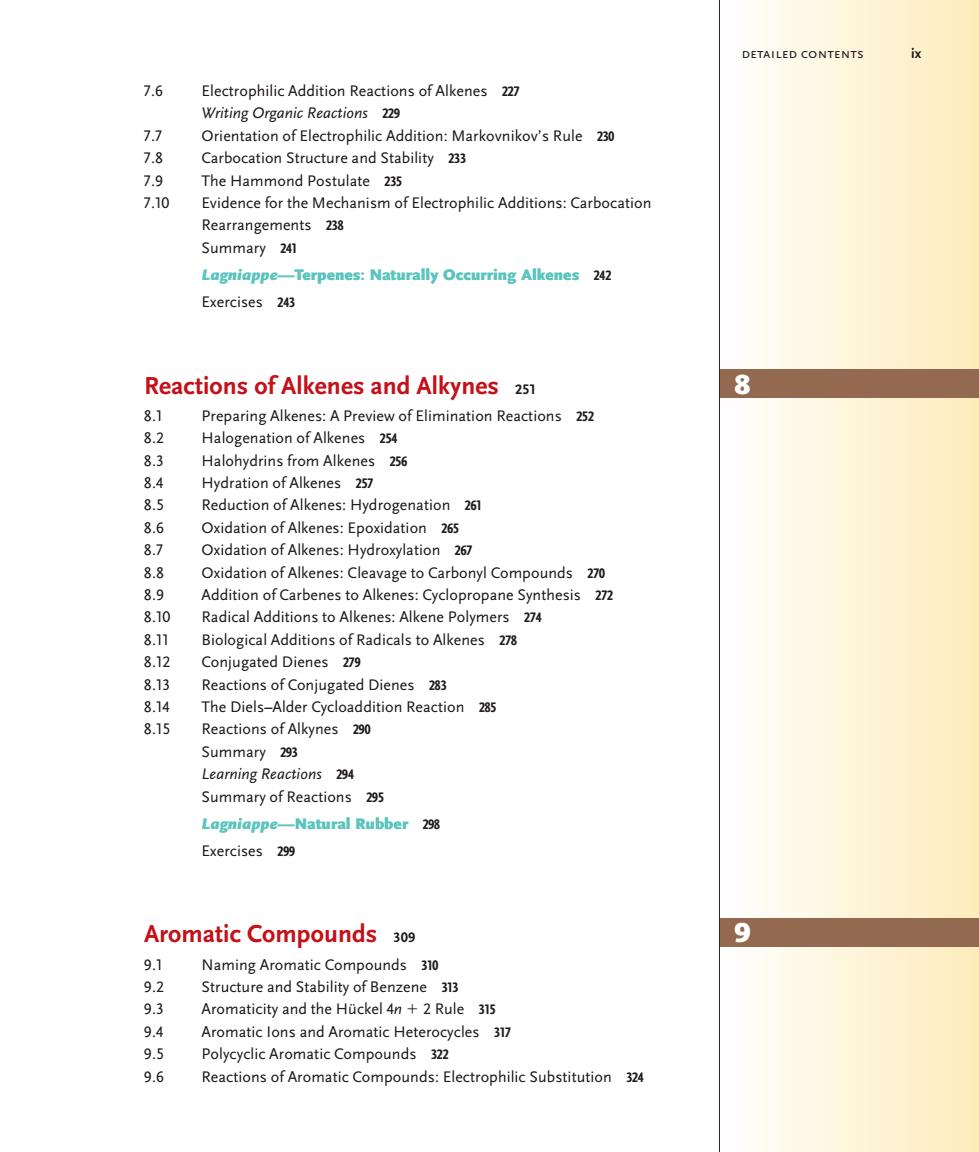
DETAILED CONTENTS 7.6 Electrophilic Addition Reactions of Alkenes 27 Writing Organic Reactions 229 Orientation of Electrophilic Addition:Markovnikov's Rule 230 Carbocation Structure and Stability 233 7.9 The Hammond Postulate 235 7.10 Evidence for the Mechanism of Electrophilic Additions:Carbocation Rearrangements 238 Summary 241 Lagniappe-Terpenes:Naturally Occurring Alkenes 242 Exercises 243 Reactions of Alkenes and Alkynes 251 8 8.1 Preparing Alkenes:A Preview of Elimination Reactions 252 8.2 Halogenation of Alkenes 254 8.3 Halohydrins from Alkenes 26 8.4 Hydration of Alk kenes 257 Reduction of Alkenes:Hydrogenation 261 8.6 Oxidation of Alkenes:Epoxidation 265 Oxidation of Alkenes:Hydroxylation 8.8 Oxidation of Alkenes:Cleavage to Carbonyl Compounds 270 8.9 Addition of Carbenes to Alkenes:Cyclopropane Synthesis 272 8.10 Radical additions to alkenes:alkene polyr mers 274 8.11 Biological Additions of Radicals to Alkenes 27 8.12 Conjugated Dienes 279 8.13 Reactions of Coniugated dienes 283 The Diels-Alder Cycloaddition Reaction 285 Reactions of Alkynes290 Summary 293 Leaming Reactions2 Summary of Reactions 295 Lagniappe-Natural Rubber29 Exercises 299 Aromatic Compounds 309 9 9.1 Naming Aromatic Compounds 310 9.2 Structure and Stability of Benzene 313 9.3 Aromaticity and the Huckel 4n+2 Rule 315 94 Aromatic lons and Aromatic Heterocycles 317 .5 Polycyclic Aromatic Compounds 322 9.6 Reactions of Aromatic Compounds:Electrophilic Substitution 324
detailed contents ix 7.6 Electrophilic Addition Reactions of Alkenes 227 Writing Organic Reactions 229 7.7 Orientation of Electrophilic Addition: Markovnikov’s Rule 230 7.8 Carbocation Structure and Stability 233 7.9 The Hammond Postulate 235 7.10 Evidence for the Mechanism of Electrophilic Additions: Carbocation Rearrangements 238 Summary 241 Lagniappe—Terpenes: Naturally Occurring Alkenes 242 Exercises 243 Reactions of Alkenes and Alkynes 251 8.1 Preparing Alkenes: A Preview of Elimination Reactions 252 8.2 Halogenation of Alkenes 254 8.3 Halohydrins from Alkenes 256 8.4 Hydration of Alkenes 257 8.5 Reduction of Alkenes: Hydrogenation 261 8.6 Oxidation of Alkenes: Epoxidation 265 8.7 Oxidation of Alkenes: Hydroxylation 267 8.8 Oxidation of Alkenes: Cleavage to Carbonyl Compounds 270 8.9 Addition of Carbenes to Alkenes: Cyclopropane Synthesis 272 8.10 Radical Additions to Alkenes: Alkene Polymers 274 8.11 Biological Additions of Radicals to Alkenes 278 8.12 Conjugated Dienes 279 8.13 Reactions of Conjugated Dienes 283 8.14 The Diels–Alder Cycloaddition Reaction 285 8.15 Reactions of Alkynes 290 Summary 293 Learning Reactions 294 Summary of Reactions 295 Lagniappe—Natural Rubber 298 Exercises 299 Aromatic Compounds 309 9.1 Naming Aromatic Compounds 310 9.2 Structure and Stability of Benzene 313 9.3 Aromaticity and the Hückel 4n 2 Rule 315 9.4 Aromatic Ions and Aromatic Heterocycles 317 9.5 Polycyclic Aromatic Compounds 322 9.6 Reactions of Aromatic Compounds: Electrophilic Substitution 324 8 9 39144_ FM_i-xxiv.indd ix 8/26/09 10:48:49 AM�

DETAILED CONTENTS 9.7 Alkylation and Acylation of Aromatic Rings:The Friedel-Crafts Reaction 331 98 Substituent Effects in Electrophilic Substitutions 336 Nucleophilic Aromatic Substitution 344 9.10 Oxidation and Reduction of Aromatic Compounds4 9.1n An Introduction to Organic Synthesis:Polysubstituted Benzenes349 Summary 355 Summary of Reactions 356 Lagniappe-Aspirin,NSAIDs,and COX-2 Inhibitors 357 Exercises 359 10 Structure Determination:Mass Spectrometry, Infrared Spectroscopy,and Ultraviolet Spectroscopy 367 10.1 Mass Spectrometry of Small Molecules:Magnetic-Sector Instruments 368 Interpreting Mass Spectra36 Mass Spectrometry of Some Common Functional Groups 373 10.4 Mass Spectrometry in Biological Chemistry:Time-of-Flight(TOF) Instruments 376 10.5 Spectroscopy and the Electromagnetic Spectrum 377 10.6 Infrared Spectroscopy 380 107 Interpreting Infrared Spectra 381 Infrared Spectra of Some Common Functional Groups 384 Ultraviolet Spectroscopy 389 10.10 Interpreting Ultraviolet Spectra:The Effect of Conjugation 391 10.11 Conjugation,Color,and the Chemistry of Vision39 Summary 394 Lagniappe-Chromatography:Purifying Organic Compounds 395 Exercises 3% 11 Structure Determination:Nuclear Magnetic Resonance Spectroscopy 404 11.1 Nuclear Magnetic Resonance Spectroscopy 405 11.2 The Nature of NMR Absorptions 406 11.3 Chemical Shifts 409 11.4 1NMR Spectroscopy Signal Averaging and FT-NMR 1.5 Characteristics of 13C NMR Spectroscopy 412 11.6 DEPT 13C NMR Spectroscopy 415 111 Uses of 13C NMR Spectroscopy 417
x detailed contents 9.7 Alkylation and Acylation of Aromatic Rings: The Friedel–Crafts Reaction 331 9.8 Substituent Effects in Electrophilic Substitutions 336 9.9 Nucleophilic Aromatic Substitution 344 9.10 Oxidation and Reduction of Aromatic Compounds 347 9.11 An Introduction to Organic Synthesis: Polysubstituted Benzenes 349 Summary 355 Summary of Reactions 356 Lagniappe—Aspirin, NSAIDs, and COX-2 Inhibitors 357 Exercises 359 Structure Determination: Mass Spectrometry, Infrared Spectroscopy, and Ultraviolet Spectroscopy 367 10.1 Mass Spectrometry of Small Molecules: Magnetic-Sector Instruments 368 10.2 Interpreting Mass Spectra 369 10.3 Mass Spectrometry of Some Common Functional Groups 373 10.4 Mass Spectrometry in Biological Chemistry: Time-of-Flight (TOF) Instruments 376 10.5 Spectroscopy and the Electromagnetic Spectrum 377 10.6 Infrared Spectroscopy 380 10.7 Interpreting Infrared Spectra 381 10.8 Infrared Spectra of Some Common Functional Groups 384 10.9 Ultraviolet Spectroscopy 389 10.10 Interpreting Ultraviolet Spectra: The Effect of Conjugation 391 10.11 Conjugation, Color, and the Chemistry of Vision 392 Summary 394 Lagniappe—Chromatography: Purifying Organic Compounds 395 Exercises 396 Structure Determination: Nuclear Magnetic Resonance Spectroscopy 404 11.1 Nuclear Magnetic Resonance Spectroscopy 405 11.2 The Nature of NMR Absorptions 406 11.3 Chemical Shifts 409 11.4 13C NMR Spectroscopy: Signal Averaging and FT–NMR 411 11.5 Characteristics of 13C NMR Spectroscopy 412 11.6 DEPT 13C NMR Spectroscopy 415 11.7 Uses of 13C NMR Spectroscopy 417 10 11 39144_ FM_i-xxiv.indd x 8/26/09 10:48:50 AM
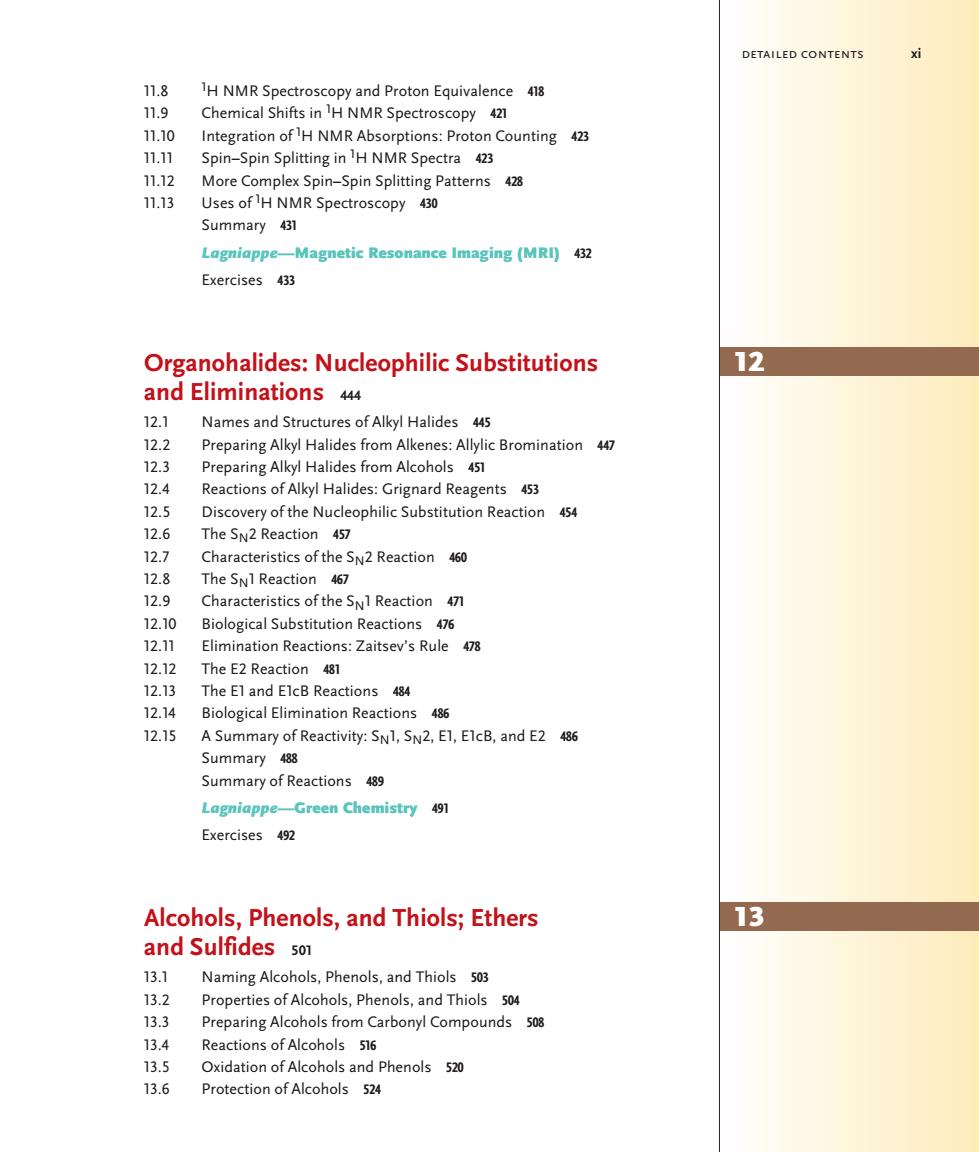
DETAILED CONTENTS 切 8 H NMR Spectroscopy and Proton Equivalence 418 11.9 Chemical Shifts in H NMR Spectroscopy 421 11.10 Integration of H NMR Absorptions:Proton Counting 423 Spin-Spin Spliting inHNMR Spectra 11.12 More Complex Spin-Spin Splitting Patterns 428 11.13 Uses of 1H NMR Spectroscopy 430 Summary 431 Lagniappe-Magnetic Resonance Imaging(MRI)432 Exercises 433 Organohalides:Nucleophilic Substitutions 12 and Eliminations 444 12.1 Names and Structures of Alkyl Halides 445 12.2 Preparing Alkyl Halides from Alkenes:Allylic Bromination 447 12.3 Preparing Alkyl Halides from Alcohols 451 12.4 Reactions of Alkyl Halides:Grignard Reagents 453 12.5 Discovery of the Nucleophilic Substitution Reaction 454 12.6 The SN2 Reaction 457 12.7 Characteristics of the SN2 Reaction 460 12.8 12.9 The SNI Reaction 467 Characteristics of the SNI Reaction 47 12.10 Biological Substitution Reactions 476 12.11 Elimination Reactions:Zaitsev's Rule 478 12.12 The E2 Reaction 12.13 The El and ElcB Reactions 484 12.14 Biological Elimination Reactions 486 12.15 A Summary of Reactivity:SN1,SN2,E1,EIcB,and E24 Summary488 Summary of Reactions 489 Lagniappe-Green Chemistry 491 Exercises 492 Alcohols,Phenols,and Thiols;Ethers 13 and Sulfides so 13.1 Naming Alcohols,Phenols,and Thiols 503 132 Properties of Alcohols,Phenols,and Thiols 504 13.3 Carbony Compounds 13.4 Reactions of Alcohols 516 13.5 Oxidation of Alcohols and Phenols 520 13.6 Protection of Alcohols 524
detailed contents xi 11.8 1 H NMR Spectroscopy and Proton Equivalence 418 11.9 Chemical Shifts in 1 H NMR Spectroscopy 421 11.10 Integration of 1 H NMR Absorptions: Proton Counting 423 11.11 Spin–Spin Splitting in 1 H NMR Spectra 423 11.12 More Complex Spin–Spin Splitting Patterns 428 11.13 Uses of 1 H NMR Spectroscopy 430 Summary 431 Lagniappe—Magnetic Resonance Imaging (MRI) 432 Exercises 433 Organohalides: Nucleophilic Substitutions and Eliminations 444 12.1 Names and Structures of Alkyl Halides 445 12.2 Preparing Alkyl Halides from Alkenes: Allylic Bromination 447 12.3 Preparing Alkyl Halides from Alcohols 451 12.4 Reactions of Alkyl Halides: Grignard Reagents 453 12.5 Discovery of the Nucleophilic Substitution Reaction 454 12.6 The SN2 Reaction 457 12.7 Characteristics of the SN2 Reaction 460 12.8 The SN1 Reaction 467 12.9 Characteristics of the SN1 Reaction 471 12.10 Biological Substitution Reactions 476 12.11 Elimination Reactions: Zaitsev’s Rule 478 12.12 The E2 Reaction 481 12.13 The E1 and E1cB Reactions 484 12.14 Biological Elimination Reactions 486 12.15 A Summary of Reactivity: SN1, SN2, E1, E1cB, and E2 486 Summary 488 Summary of Reactions 489 Lagniappe—Green Chemistry 491 Exercises 492 Alcohols, Phenols, and Thiols; Ethers and Sulfides 501 13.1 Naming Alcohols, Phenols, and Thiols 503 13.2 Properties of Alcohols, Phenols, and Thiols 504 13.3 Preparing Alcohols from Carbonyl Compounds 508 13.4 Reactions of Alcohols 516 13.5 Oxidation of Alcohols and Phenols 520 13.6 Protection of Alcohols 524 12 13 39144_ FM_i-xxiv.indd xi 8/26/09 10:48:50 AM
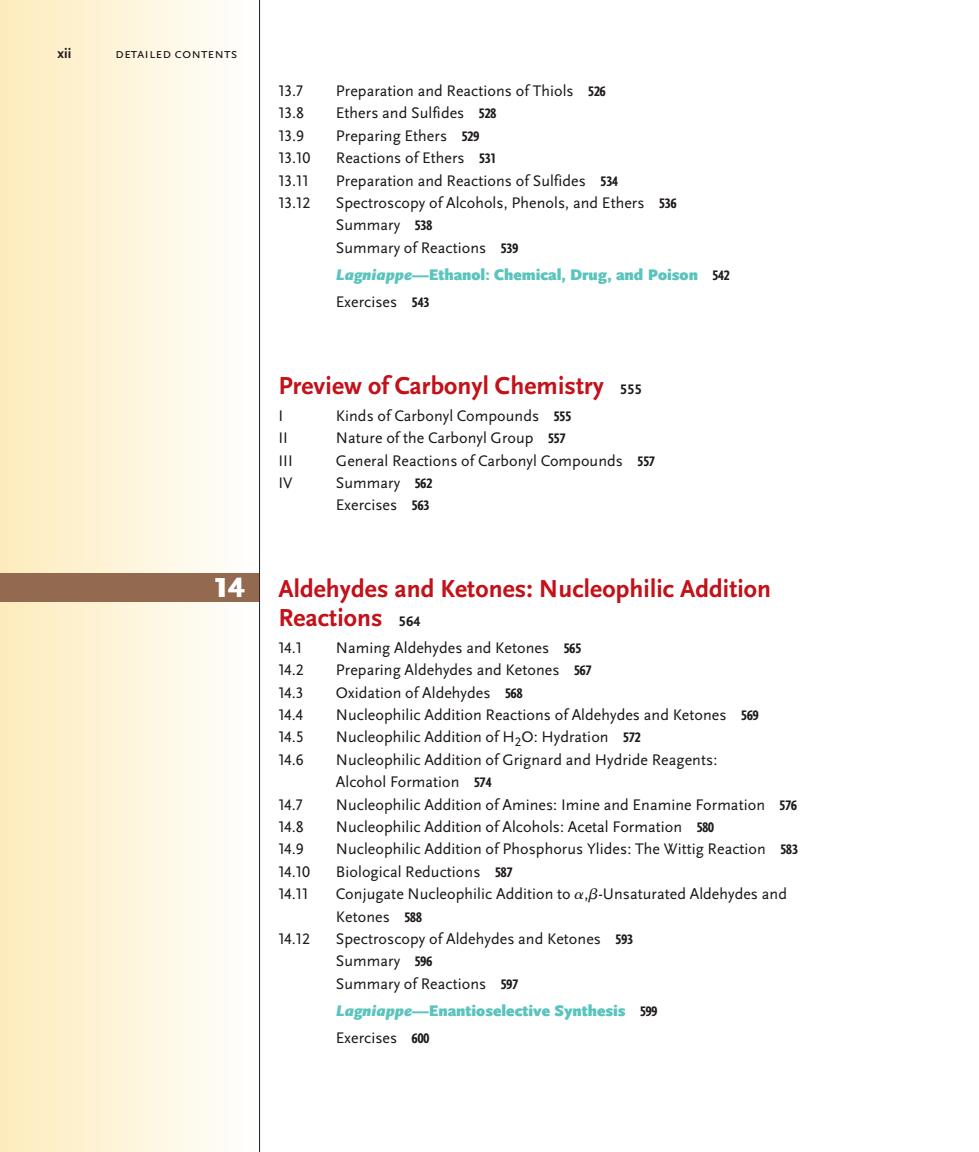
DETAILED CONTENTS 13.7 Preparation and Reactions of Thiols 526 138 Ethers and Sulfides 528 13.9 Preparing Ethers 529 13.10 Reactions of Ethers 531 13.11 Preparation and Reactions of Sulfides 534 13.12 Ethers Summary 538 Summary of Reactions 539 Lagniappe-Ethanol:Chemical,Drug,and Poison 542 Exercises 543 Preview of Carbonyl Chemistry sss W General Reactions of Carbonyl Compounds 557 IV Summary 562 Exercises 563 14 Aldehydes and Ketones:Nucleophilic Addition Reactions 564 14.1 Naming Aldehydes and Ketones 565 14.2 Preparing Aldehydes and Ketones 567 14.3 Oxidation of Aldehydes56 14.4 Nucleophilic Addition Reactions of Aldehydes and Ketones 569 14.5 Nucleophilic Addition of H2O:Hydration 572 14.6 Nucleophilic Addition of Grignard and Hydride Reagents: Alcohol Formation 574 14.7 Nucleophilic Addition of Amines:Imine and Enamine Formation 576 14.8 Nucleophilic Addition ofAlcohols:Acetal Formation 580 14.9 Nucleophilic Addition of Phosphorus Ylides:The Wittig Reaction5 14.10 Biological Reductions 587 14.11 Conjugate Nucleophilic Addition to a,B-Unsaturated Aldehydes and Ketones 14.12 Spectroscopy of Aldehydes and Ketones 593 Summary 596 Summary of Reactions 597 Lagniappe-Enantioselective Synthesis599 Exercises 600
xii detailed contents 13.7 Preparation and Reactions of Thiols 526 13.8 Ethers and Sulfides 528 13.9 Preparing Ethers 529 13.10 Reactions of Ethers 531 13.11 Preparation and Reactions of Sulfides 534 13.12 Spectroscopy of Alcohols, Phenols, and Ethers 536 Summary 538 Summary of Reactions 539 Lagniappe—Ethanol: Chemical, Drug, and Poison 542 Exercises 543 Preview of Carbonyl Chemistry 555 I Kinds of Carbonyl Compounds 555 II Nature of the Carbonyl Group 557 III General Reactions of Carbonyl Compounds 557 IV Summary 562 Exercises 563 Aldehydes and Ketones: Nucleophilic Addition Reactions 564 14.1 Naming Aldehydes and Ketones 565 14.2 Preparing Aldehydes and Ketones 567 14.3 Oxidation of Aldehydes 568 14.4 Nucleophilic Addition Reactions of Aldehydes and Ketones 569 14.5 Nucleophilic Addition of H2O: Hydration 572 14.6 Nucleophilic Addition of Grignard and Hydride Reagents: Alcohol Formation 574 14.7 Nucleophilic Addition of Amines: Imine and Enamine Formation 576 14.8 Nucleophilic Addition of Alcohols: Acetal Formation 580 14.9 Nucleophilic Addition of Phosphorus Ylides: The Wittig Reaction 583 14.10 Biological Reductions 587 14.11 Conjugate Nucleophilic Addition to ,-Unsaturated Aldehydes and Ketones 588 14.12 Spectroscopy of Aldehydes and Ketones 593 Summary 596 Summary of Reactions 597 Lagniappe—Enantioselective Synthesis 599 Exercises 600 14 39144_ FM_i-xxiv.indd xii 8/26/09 10:48:50 AM��

DETAILED CONTENTS Carboxylic Acids and Nitriles 610 15 15.1 Naming Carboxylic Acids and Nitriles 611 15.2 Structure and Properties of Carboxylic Acids 613 15.3 Biological Acids and the Henderson-Hasselbalch Equation 617 15.4 Substituent Effects on Acidity 618 15.5 Preparing 15.6 Reactions of Carboxylic Acids:An Overview 62 15.7 Chemistry of Nitriles 623 15.8 Spectroscopy of Carboxylic Acids and Nitriles6 Summary 629 Summary of Reactions 630 Lagniappe-Vitamin C 631 Exercises 633 Carboxylic Acid Derivatives:Nucleophilic Acyl 16 Substitution Reactions 643 16.1 Naming Carboxylic Acid Derivatives 644 16.2 Nucleophilic Acyl Substitution Reactions 647 16.3 Nucleophilic Acyl Substitution Reactions of Carboxylic Acids 652 16.4 Chemistry of Acid Halides 659 16.5 Chemistry of Acid Anhydrides 664 16.6 Chemistry of Esters 16.7 Chemistry of Amides 67 16.8 Chemistry of Thioesters and acyl Phosphates:Biological Carboxylic acid Derivatives 674 16.9 Polyamides and Polyesters:Step-Growth Polymers 675 16.10 Spectroscopy of Carboxylic Acid Derivatives 679 Summary 680 Summary of Reactions 681 Lagniappe-B-Lactam Antibiotics6 Exercises 684 Carbonyl Alpha-Substitution and Condensation 17 Reactions 695 17.1 Keto-Enol Tautomerism6% 17.2 Reactivity of Enols:a-Substitution Reactions 699 17.3 Alpha bromination of Carboxylic acids 702 17.4 Acidity of Hydrogen Atoms:Enolate lon Formation 703 17.5 Alkylation of Enolate lons 706
detailed contents xiii Carboxylic Acids and Nitriles 610 15.1 Naming Carboxylic Acids and Nitriles 611 15.2 Structure and Properties of Carboxylic Acids 613 15.3 Biological Acids and the Henderson–Hasselbalch Equation 617 15.4 Substituent Effects on Acidity 618 15.5 Preparing Carboxylic Acids 620 15.6 Reactions of Carboxylic Acids: An Overview 622 15.7 Chemistry of Nitriles 623 15.8 Spectroscopy of Carboxylic Acids and Nitriles 627 Summary 629 Summary of Reactions 630 Lagniappe—Vitamin C 631 Exercises 633 Carboxylic Acid Derivatives: Nucleophilic Acyl Substitution Reactions 643 16.1 Naming Carboxylic Acid Derivatives 644 16.2 Nucleophilic Acyl Substitution Reactions 647 16.3 Nucleophilic Acyl Substitution Reactions of Carboxylic Acids 652 16.4 Chemistry of Acid Halides 659 16.5 Chemistry of Acid Anhydrides 664 16.6 Chemistry of Esters 665 16.7 Chemistry of Amides 671 16.8 Chemistry of Thioesters and Acyl Phosphates: Biological Carboxylic Acid Derivatives 674 16.9 Polyamides and Polyesters: Step-Growth Polymers 675 16.10 Spectroscopy of Carboxylic Acid Derivatives 679 Summary 680 Summary of Reactions 681 Lagniappe—-Lactam Antibiotics 683 Exercises 684 Carbonyl Alpha-Substitution and Condensation Reactions 695 17.1 Keto–Enol Tautomerism 696 17.2 Reactivity of Enols: -Substitution Reactions 699 17.3 Alpha Bromination of Carboxylic Acids 702 17.4 Acidity of Hydrogen Atoms: Enolate Ion Formation 703 17.5 Alkylation of Enolate Ions 706 15 16 17 39144_ FM_i-xxiv.indd xiii 8/26/09 10:48:50 AM���